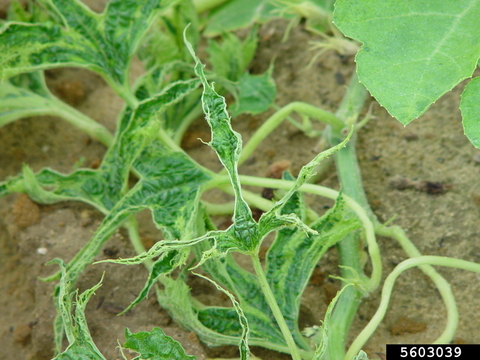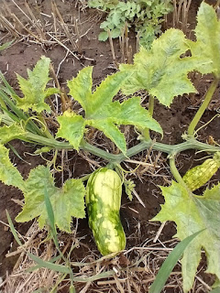Quick facts
- Viral infections commonly occur on all cucurbit crops in Minnesota.
- Virus-infected leaves often have a mottling or mosaic pattern in shades of green and yellow. It is difficult to identify the specific virus from visual symptoms alone. Submitting samples to a plant disease clinic is the only way to confirm the species.
- Certain perennial weeds allow viruses to survive from season to season in a field. Aphids then transfer the virus to cucurbits.
- There are no pesticides available to reverse or limit the symptoms of viral infection.
Telling viruses apart from other plant issues
It is difficult to identify a virus by symptoms alone. Symptoms vary depending on the crop, variety, age of the plant at the time of infection, and in some cases weather. It is common to find plants infected with more than one virus at the same time, often resulting in combined severe symptoms. The best way to identify viruses is through analysis of a sample at the University of Minnesota Plant Diagnostic Clinic.
- Virus-infected leaves often have a mottling or mosaic pattern in shades of green and yellow. This mosaic can be very distinct and obvious, or subtle.
- Leaves are often distorted or deformed. They may be puckered, cupped under, have deep lobes, or appear thin and string-like.
- Young leaves often show the most severe symptoms and are abnormally small. Growth on infected vines is typically stunted. In the case of cucumber mosaic virus (CMV) infections, the vines may wither completely.
- The virus's effect on fruit depends on when it infected the plant. Early infections often result in no or very low fruit production.
- Later infection can result in fruit that is small, deformed and discolored. Fruit may have a mottled or mosaic pattern, ring spots or off-coloration on all or part of the fruit. Melons infected with squash mosaic virus (SqMV) often lack netting at maturity.
Biology
- Specific cucurbit viruses include Cucumber Mosaic Virus (CMV), Squash Mosaic Virus (SqMV), Zucchini Yellow Mosaic Virus (ZYMV), Watermelon Mosaic Virus 2 (WMV-2) and Watermelon Mosaic Virus 1 (WMV-1), also known as Papaya Ringspot Virus (PRSV).
- All of the mosaic viruses can infect all of the cucurbit crops including melon, cucumber, pumpkin, summer and winter squash. In addition, many of the mosaic viruses can also infect common weeds.
- Squash mosaic virus will infect weeds in the Chenopodiaceae family like common lambsquarters, maple leaf goosefoot, Russian thistle and kochia.
- Watermelon mosaic virus infects legumes like clover.
- Cucumber mosaic virus can infect plants from over forty families, including vegetable crops like tomato, lettuce and spinach, flower crops like gladiolus, petunias, impatiens and rudbeckia, and a wide variety of weeds.
- All of the mosaic viruses can also infect weeds in the cucurbit family.
- These viruses, with the exception of SqMV, are transferred by aphids. Not all aphids carry viruses. Aphids that feed on infected weeds and crops pick up the virus, and as they move on and feed on other plants, spread the virus.
- SqMV is transmitted by both striped and spotted cucumber beetles.
- Perennial weeds allow the virus to survive from season to season in a field.
- Viruses can transfer from plant to plant on the hands and tools of workers through infected sap.
- Once in the plant, viruses move systemically through the tissue, infecting leaves, vines and fruit.
- Squash mosaic virus can be introduced on infected seed. The other mosaic viruses rarely transfer on seed
Managing cucurbit viruses in the home garden
Many viruses cause similar symptoms, but it is impossible to confirm without a diagnosis from a plant pathology lab. Something that can often be mistaken for viruses in home garden settings is herbicide damage from products used on lawns. For information on this, see “Herbicide Injury on garden plants.” You can send plants to the University of Minnesota Plant Disease Clinic for diagnosis.
There are resistant varieties available for some cucurbit viruses. Look for a table of disease codes for disease resistance in your catalogs . No variety can completely protect plants from all viruses.
Suspected virus-infected plants should be removed so they do not serve as a reservoir for the virus in the garden.
Managing cucurbit viruses on farms
Scout plants regularly. If plants displaying symptoms of viruses are found, remove the entire plant (including roots), bag the plant, and send it to the University of Minnesota Plant Disease Clinic for diagnosis.
- Plant resistant or tolerant varieties whenever available.
- Resistance is virus specific and it is necessary to determine first which mosaic virus is causing disease in order to select appropriate varieties.
- Purchase clean seed from a reputable supplier. If saving seeds, do not collect seed from infected plants.
- Control weeds within and around the field. Focus control efforts on perennial weeds that may allow the virus to carry over from one season to the next.
- Keep aphid and cucumber beetle populations low.
- If disease appears in a few plants, remove and bury these plants to prevent further spread of the disease.
- Clean tools and hands with soap and water after working with infected plants. Reduce maintenance tasks that require handling of infected plants as much as possible.
- In greenhouse or hoop house production, use screening and other methods to exclude aphids. Eliminate weeds or other virus hosts within 350 feet of the greenhouse or hoop house.
- Avoid planting cucurbit field crops next to hoop houses or greenhouse production areas.
- There are no pesticides available to reverse or limit the symptoms of viral infection.
- Insecticides that control aphids often kill their natural enemies, resulting in a rising aphid population after spraying.
CAUTION: Mention of a pesticide or use of a pesticide label is for educational purposes only. Always follow the pesticide label directions attached to the pesticide container you are using. Be sure that the plant you wish to treat is listed on the label of the pesticide you intend to use. And observe the number of days between pesticide application and when you can harvest your crop. Remember, the label is the law.
Reviewed in 2021





